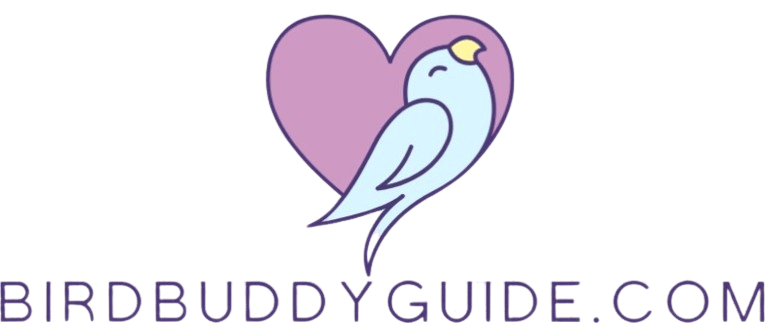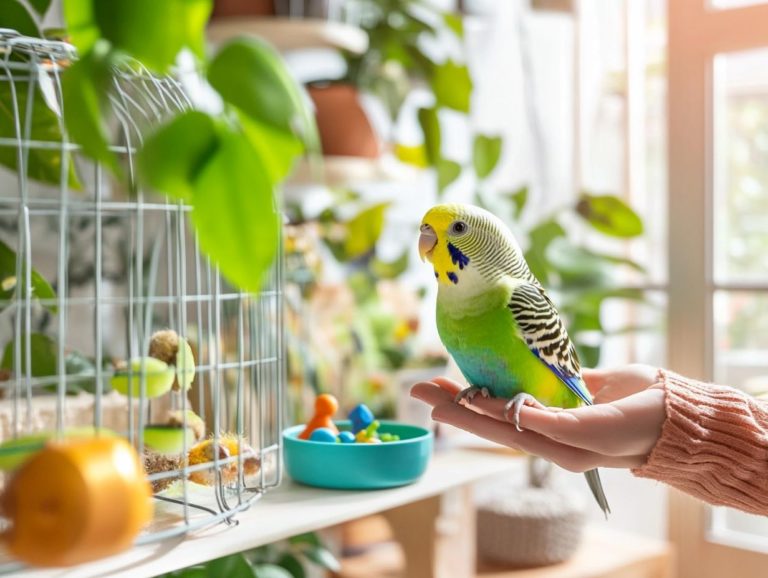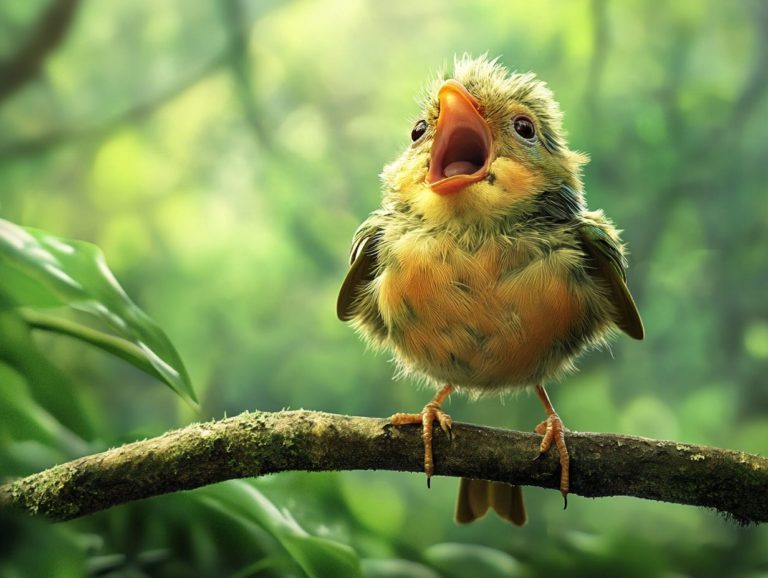The Effects of Loud Noise on Avian Health
Birds are truly remarkable creatures, relying heavily on sound for communication, navigation, and survival. However, the rising tide of noise pollution poses a significant threat to their well-being.
From urban construction sites to the relentless hum of busy highways, these loud noises disrupt their natural behaviors, leading to both physical and behavioral changes.
This article delves into the intricate relationship between noise pollution and avian health, examining its sources, effects, and potential solutions to protect your feathered friends and their habitats.
Discover the challenges birds face in an increasingly noisy world and the conservation efforts dedicated to safeguarding their future.
Contents
- Key Takeaways:
- The Impact of Noise Pollution on Birds
- How Loud Noise Affects Birds
- Common Sources of Loud Noise for Birds
- Preventing Noise-Related Health Issues in Birds
- Protecting Avian Habitats from Noise Pollution
- Frequently Asked Questions
- What are the main effects of loud noise on avian health?
- Which types of loud noise are most harmful to avian health?
- Are some bird species more susceptible to the effects of loud noise than others?
- How can loud noise affect avian reproduction?
- What are some potential long-term consequences of exposure to loud noise for birds?
- Is there anything that can be done to mitigate the effects of loud noise on avian health?
Key Takeaways:

- Loud noise can have negative effects on avian health, including physical and behavioral changes.
- Human activities and environmental factors are common sources of loud noise for birds.
- Strategies for reducing noise pollution and conservation efforts are crucial in protecting avian habitats and preventing noise-related health issues.
The Impact of Noise Pollution on Birds
Noise pollution profoundly affects bird species, shaping their health, behavior, and reproductive success. In urban environments, the cacophony of traffic and gas compressors disrupt communication signals among birds, resulting in heightened stress levels and chronic anxiety.
This disturbance doesn t just impact individual birds; it threatens entire ecosystems and their resilience in the face of habitat degradation. Research shows that higher stress hormones due to noise pollution reduce breeding success and hinder feather growth across various avian species.
Overview of Avian Hearing and Communication
Avian hearing and communication play crucial roles in bird life. They shape behaviors such as mating, predator detection, and social interactions among species.
You ll find that birds employ a wide array of communication signals, including songs and calls. These signals convey vital information, establish territories, and attract mates.
Take songbirds, for example. They often engage in differing sounds that not only announce their presence but also help establish intricate social hierarchies.
Species like zebra finches showcase specific auditory adaptations, such as a specialized cochlea, enhancing their ability to discern the frequencies crucial for communication.
As urban areas expand and infrastructure develops, these birds encounter significant challenges, including increased background noise that can drown out their signals. This interference complicates their mating rituals and hampers their ability to alert against predators. It emphasizes the urgent need for urban planning that considers these distinctive avian communication methods.
How Loud Noise Affects Birds
Loud noise can profoundly affect birds, inducing both physical and behavioral changes that ultimately compromise their reproductive success. To understand how environmental factors like sound interact with temperature, it’s essential to consider the impact of temperature on bird health. Prolonged exposure to high decibel levels, especially prevalent in urban areas, has been associated with heightened stress levels in these creatures.
This stress can alter their mating behaviors and overall fitness, raising serious concerns. Research suggests that chronic stress responses to noise pollution can hinder feather growth and disrupt essential communication signals vital for survival.
It’s urgent that we tackle the noise pollution problem to protect our birds!
Physical and Behavioral Changes

Physical and behavioral changes in birds, especially in species like the western bluebirds, can be directly linked to the stress caused by noise pollution. Increased stress affects individual birds. It can also compromise their reproductive success and impact entire populations.
For example, studies reveal that in high-noise environments, western bluebirds modify their vocalizations. This disrupts the crucial communication needed for mating rituals. Research also indicates that consistent noise exposure interferes with parenting behaviors, as these birds struggle to hear their chicks calls amid the chaos. This disturbance hampers feeding and protection, threatening the health and survival rates of the chicks.
Ultimately, the cumulative effects of these behavioral changes lead to diminished breeding success. This raises serious concerns about the long-term viability of not just bluebirds but numerous avian species living in noisy habitats.
Common Sources of Loud Noise for Birds
Common sources of loud noise that impact birds include human activities and various environmental factors. Among the most pervasive are traffic noise and the industrial sounds emanating from gas compressors.
These disturbances create immediate disruptions and can lead to long-term consequences for avian populations and their habitats.
Human Activities and Environmental Factors
Human activities and environmental factors significantly contribute to noise pollution, especially in urban areas where habitat degradation is rampant. The interplay of urbanization, rising traffic, and industrial activities creates a challenging atmosphere for bird species, adversely impacting their ecosystems.
As construction projects reshape landscapes and transportation hubs expand, you may see birds facing even tougher challenges. Their natural habitats become fragmented or destroyed, altering their nesting habits and elevating stress levels. This makes it harder for them to communicate, mate, and forage for food.
As a result, many bird populations may see declines or shifts in behavior, ultimately leading to a decrease in biodiversity. We must prioritize thoughtful urban planning and the incorporation of green spaces to provide quieter zones that foster coexistence between human communities and wildlife.
Preventing Noise-Related Health Issues in Birds
Preventing noise-related health issues in birds is crucial for maintaining biodiversity and fostering vibrant ecosystems. By implementing effective strategies to reduce noise pollution, you can significantly enhance avian health outcomes and boost their reproductive success.
Strategies for Reducing Noise Pollution

There are several effective strategies you can employ to reduce noise pollution, especially in urban areas, with the support of citizen-science initiatives. These conservation efforts aim to create quieter environments that benefit various bird species, enhancing their health and breeding success.
By leveraging technology, such as sound mapping apps that help identify noise levels, you can gather valuable data that highlights noise hotspots in your community. This data collection raises awareness and gives the power to local groups to advocate for sound mitigation measures, like planting more trees and improving urban planning.
Implementing sound barriers and encouraging the use of quieter machinery decreases auditory disturbances significantly. Together, these strategies foster a collaborative atmosphere that promotes awareness, ultimately leading to more informed conservation policies and a healthier ecosystem.
Protecting Avian Habitats from Noise Pollution
Protecting avian habitats from noise pollution is vital for conservation efforts dedicated to nurturing healthy ecosystems. By adopting best practices for habitat management, you can cultivate environments that are more resilient against the adverse impacts of environmental noise, ultimately safeguarding the survival of diverse bird species.
Join us in protecting our feathered friends by advocating for quieter environments!
Conservation Efforts and Best Practices
Conservation efforts aimed at protecting ecosystems and bird species are vital for mitigating noise pollution. You can create sustainable environments that support bird populations by managing their habitats.
Organizations like California Polytechnic State University invest in research for habitat restoration. Their work promotes community involvement, strengthening local ecosystems and fostering responsibility.
The Florida Museum of Natural History educates the public about bird diversity. They work with communities and governments to protect critical habitats.
Engaging citizens in monitoring bird populations enhances conservation efforts. Your involvement can make a real impact!
Frequently Asked Questions
What are the main effects of loud noise on avian health?

Loud noise can cause hearing damage, increased stress levels, and disruption to normal behaviors in birds, leading to decreased health and potentially even death. For more insights, consider reading about understanding bird vocalizations and health.
Which types of loud noise are most harmful to avian health?
Anthropogenic sources of noise, such as construction, traffic noise, and industrial activities like gas compressors, are generally the most harmful to avian health. They are often continuous and can disrupt natural habitats.
Are some bird species more susceptible to the effects of loud noise than others?
Yes, certain bird species, such as songbirds, zebra finches, and waterfowl, are more sensitive to loud noise. They can experience more severe health impacts compared to other species like raptors.
How can loud noise affect avian reproduction?
Loud noise can disrupt breeding behaviors, cause nest abandonment, and reduce reproductive success in birds. This leads to declines in population numbers, particularly in sensitive species like western bluebirds and tree swallows.
What are some potential long-term consequences of exposure to loud noise for birds?
Birds that are regularly exposed to loud noise may experience chronic stress, elevated corticosterone levels, and reduced immune function. Understanding the impact of noise on bird housing is crucial, as this makes them more susceptible to disease and other health issues.
Is there anything that can be done to mitigate the effects of loud noise on avian health?
Yes, you can help reduce noise effects by creating buffer zones between loud sources and bird homes. Citizen-science initiatives like FeederWatch and NestWatch educate the public about the effects of loud noise on birds and promote more responsible actions around bird habitats.
Join us in protecting our feathered friends by staying informed and engaged!






